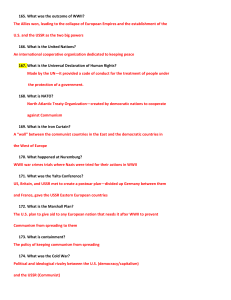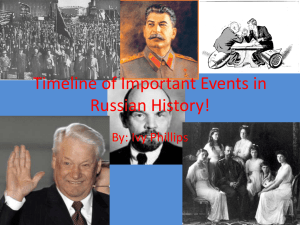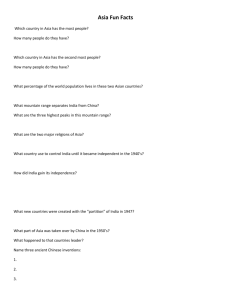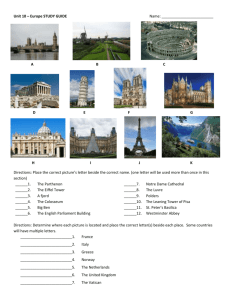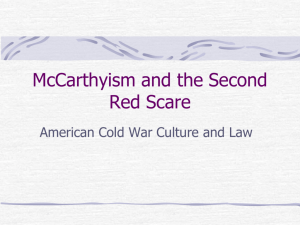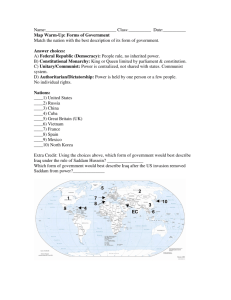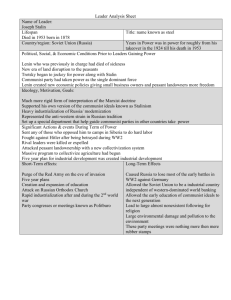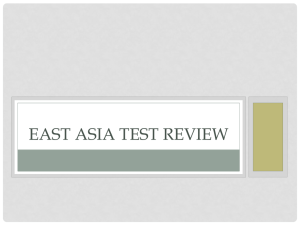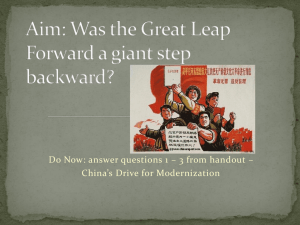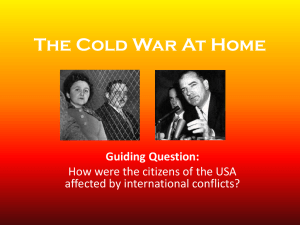wh unit 5 vocab
advertisement
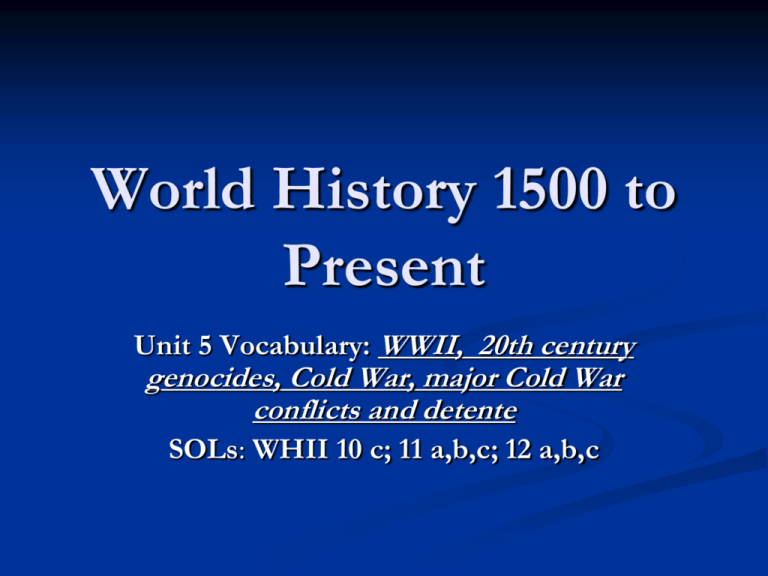
World History 1500 to Present Unit 5 Vocabulary: WWII, 20th century genocides, Cold War, major Cold War conflicts and detente SOLs: WHII 10 c; 11 a,b,c; 12 a,b,c General Hideki Tojo This person was the prime minister of Japan from 1941 to 1944. Emperor Hirohito After the second nuclear explosion in his land, this ruler ordered his military leaders to do the unthinkable: surrender. Appeasement This term means giving in to the demands of an aggressor in order to maintain peace. Franklin D. Roosevelt This person was president of the United States during World War II and one third of “The Big Three.” Winston Churchill This person was the prime minister of Great Britain during World War II and one third of “The Big Three.” Erwin Rommel This person was the German tank commander of the Afrika Korps and was nicknamed, “the Desert Fox.” Dwight D. Eisenhower This US general led Operation Torch in North Africa and was later named supreme commander of the Allied forces in Europe. He was well liked by the troops and would later become president of the United States. D-Day This amphibious Allied invasion happened on June 6, 1944 near Normandy, France. About 6,603 US Soldiers died of the approx. 10,000 Allied casualties there sanctions This term refers to some kind of official penalty, most often an economic one. Nuremberg Trials These were held to try Nazi leaders as war criminals after World War II and establish the concept that “following orders” is not an excuse for committing atrocities against humanity. Bataan Death March This infamous war crime involved the forcible transfer of Allied prisoners of war by the Japanese. The abuse and mistreatment of the POWs resulted in high fatalities in the Philippines in 1942. Rape of Nanjing This infamous war crime happened in China after the Japanese invaded and occupied the city. The Japanese committed rape, arson, looting, and widespread executions of men, women, and children in addition to enemy combatants. Geneva Convention This international agreement laid out the rules of engagement in war and established a code of ethics regarding treatment of prisoners of war. Iron Curtain This term refers to the imaginary boundary between the mostly democratic west and the communist east that became a symbol of the Cold War. General Douglas MacArthur This US general oversaw the occupation of Japan and the American program of destroying Japanese militarism and ensuring a democratic government. NATO This military alliance formed between western nations who agreed to protect one another if one was attacked. Warsaw Pact This military alliance was headed by the Soviet Union and was used mainly to keep their satellite states in Eastern Europe in line. Marshall Plan This massive financial aid package from the United States was designed to assist war torn European nations in recovering quickly and resisting communist expansion. Truman Doctrine This describes the foreign policy of the United States that aimed to provide aid to countries trying to resist the threat of communist expansion. Breshnev Doctrine This describes the foreign policy of the Soviet Union that justified military intervention to prevent satellite nations from rejecting communism. Cultural Revolution This was Mao Zedong’s attempt to purge China of non-revolutionary tendencies in society by closing schools and by persecuting the educated, affluent, and intelligent. This program forced thousands from their jobs and onto farms where they would be “reeducated.” Ho Chi Minh This Vietnamese nationalist led communists to resist Western imperialism in Vietnam. Pol Pot This person pursued an aggressive policy of relocating people to work in countryside fields in an attempt to purify Cambodia as a step toward a communist future. He is regarded as one of the foremost mass murderers in human history. Khmer Rouge This is the name given to the Cambodian communist guerillas that overthrew the Cambodian government and unleashed a reign of terror to destroy all Western influences in Cambodia. They killed over 2 million people and forced thousands more to work in fields. Nikita Krushchev This leader of the USSR after Stalin surprised the Kremlin by denouncing Stalin’s rule. He later would smash Hungarian freedom fighters, bring the world to the brink of nuclear war in the Cuban Missile Crisis, and bang his own shoe at a United Nations session while declaring to America: “We will bury you!” Ayatollah Khomeini This fundamentalist Shia cleric from Iran took over the Shah’s government and restored strict Islamic law to guide all areas of Iranian life. Imre Nagy This communist reformer was a strong Hungarian nationalist who led freedom fighters in an unsuccessful rebellion against the USSR. He was executed for his actions. Alexander Dubcek This reform minded Czechoslovakian communist was expelled from the party in 1970, only to later regain influence and prominence when communists agreed to share power in a coalition government. 1989 The tragic car accident in September During this Prague 1992, after we which Spring,….what needDubcek succumbed heavy injuries two months later, toto create is “socialism shrouded in mystery, withremains a human face” although the Slovak police closed the case two years ago, saying it really was an accident. But Dubcek will always be remembered as a man who made Czechoslovak history. Detente This term refers to the relaxation of tensions between the USA and the USSR. It improved relations between both superpowers. Strategic Arms Limitation Talks (SALT) This was a 5 year treaty to limit the number of missiles to 1972 levels between the USA and the USSR.
